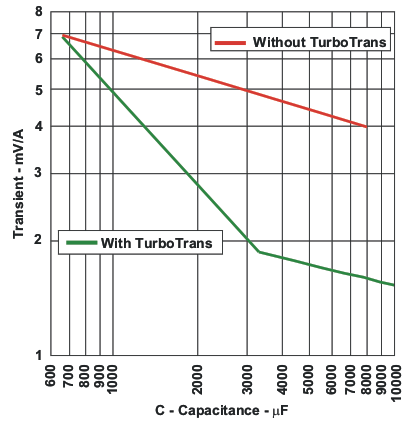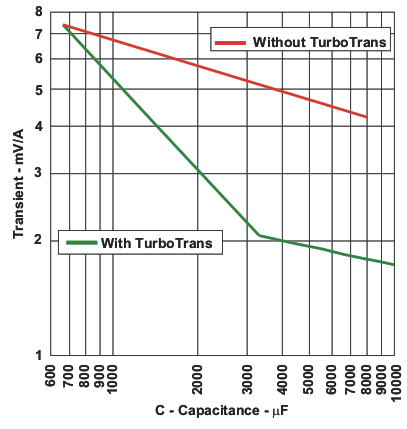SLTS278J November 2010 – March 2020 PTH08T250W
PRODUCTION DATA.
- 1 Features
- 2 Applications
- 3 Description
- 4 Revision History
- 5 Description (continued)
- 6 Pin Configuration and Functions
- 7 Specifications
- 8 Detailed Description
-
9 Application and Implementation
- 9.1
Typical Application
- 9.1.1
Detailed Design Procedure
- 9.1.1.1 Adjusting the Output Voltage
- 9.1.1.2
Capacitor Recommendations for the PTH08T250W Power Module
- 9.1.1.2.1 Capacitor Technologies
- 9.1.1.2.2 Input Capacitor (Required)
- 9.1.1.2.3 Input Capacitor Information
- 9.1.1.2.4 Output Capacitor (Required)
- 9.1.1.2.5 Output Capacitor Information
- 9.1.1.2.6 TurboTrans Output Capacitance
- 9.1.1.2.7 Non-TurboTrans Output Capacitance
- 9.1.1.2.8 Designing for Fast Load Transients
- 9.1.1.2.9 Capacitor Table
- 9.1.1.3 TurboTrans™ Technology
- 9.1.1.4 TurboTrans™ Selection
- 9.1.1.5 Undervoltage Lockout (UVLO)
- 9.1.1.6 On/Off Inhibit
- 9.1.1.7 Current Sharing
- 9.1.1.8 Prebias Startup Capability
- 9.1.1.9 SmartSync Technology
- 9.1.1.10 Auto-Track™ Function
- 9.1.1
Detailed Design Procedure
- 9.1
Typical Application
- 10Device and Documentation Support
- 11Mechanical, Packaging, and Orderable Information
Package Options
Refer to the PDF data sheet for device specific package drawings
Mechanical Data (Package|Pins)
- BCU|22
- ECT|22
- ECU|22
Thermal pad, mechanical data (Package|Pins)
Orderable Information
9.1.1.4.1 PTH08T250W Type B Capacitors
 Figure 15. Capacitor Type B,
Figure 15. Capacitor Type B,
1000 < C(μF)×ESR(mΩ) ≤ 5000 (e.g. Polymer-Tantalum)
 Figure 16. Capacitor Type B,
Figure 16. Capacitor Type B,
1000 < C(μF)×ESR(mΩ) ≤ 5000 (e.g. Polymer-Tantalum)
Table 5. Type B TurboTrans CO Values and Required RTT Selection Table
| Transient Voltage Deviation (mV) | 12 Volt Input | 5 Volt Input | ||||
|---|---|---|---|---|---|---|
| 25% load step
(12.5 A) |
50% load step
(25 A) |
75% load step
(37.5 A) |
CO
Minimum Required Output Capacitance (μF) |
RTT
Required TurboTrans Resistor (kΩ) |
CO
Minimum Required Output Capacitance (μF) |
RTT
Required TurboTrans Resistor (kΩ) |
| 100 | 200 | 300 | 660 | open | 660 | open |
| 85 | 170 | 255 | 660 | open | 750 | 226 |
| 75 | 150 | 225 | 800 | 143 | 870 | 93.1 |
| 60 | 120 | 180 | 1050 | 46.4 | 1150 | 34.8 |
| 50 | 100 | 150 | 1300 | 24.9 | 1450 | 18.7 |
| 40 | 70 | 105 | 1750 | 11.3 | 1950 | 8.45 |
| 30 | 60 | 90 | 2500 | 3.48 | 2800 | 1.87 |
| 25 | 50 | 75 | 3100 | 0.649 | 4000 | short |